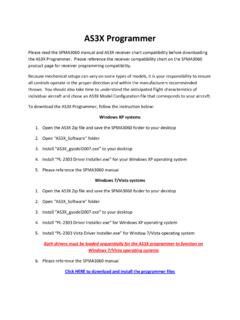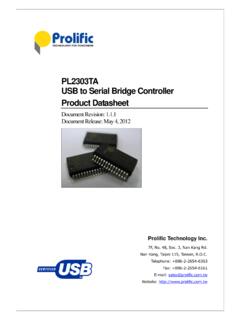Transcription of GPS Mouse User’s Guide V1.0 (WIN) - GlobalSat
1 GPS Mouse user s Guide (WIN) USB GPS Receiver: BU-353S4(SiRF IV) RS-232 GPS Receiver: BR-355S4(SiRF IV) DOCUMENT REVISIONS REV NO. 2011/9/13 Initial document LEE 2011 GlobalSat Technology Corporation/USGlobalsat, Inc. All rights reserved. The GlobalSat logo is a trademark of GlobalSat Corporation. Windows is a register trademark of Microsoft Corporation. Acrobat is a registered trademark of Adobe Systems Incorporated. Mac is a registered trademark of the Apple Corporation. All other trademarks or registered trademarks are acknowledged as the exclusive property of their respective owners. All rights reserved. No part of this manual may be reproduced, transmitted, copied, or stored in any storage medium, for any purpose, without prior written consent from GlobalSat Technology Corporation or USGlobalsat, Inc.
2 GlobalSat /USGlobalsat hereby grants the right to download one (1) copy of this manual onto a hard drive for personal use. This manual is copyrighted and may contain proprietary information that is subject to change without notice. Table of Contents PACKAGE CONTENTS .. 4 SYSTEM REQUIREMENTS .. 4 WELCOME .. 4 1. GETTING STARTED .. 4 2. INSTALLING THE USB DRIVER TO YOUR LAPTOP .. 5 3. COM PORT VERIFICATION .. 5 4. INITIALIZING YOUR GPS 6 5. USING / TESTING YOUR GPS RECEIVER .. 6 6. UN-INSTALL THE USB DRIVER .. 8 7. FAQ s .. 8 8. CONTACT INFORMATION .. 9 9. SAFETY AND LEGAL NOTICES .. 10 10. LIMITED WARRANTY .. 11 11. BU-353S4 SPECIFICATIONS .. 12 12. BR-355S4 SPECIFICATIONS .. 13 13. BU-353S4 / BR-355S4 Product Pin Description .. 14 PACKAGE CONTENTS - USB GPS Receiver - Driver CD-ROM with user s Guide and test utility for WIN and Mac O/S* WIN Users please refer to the root directory on the included CD-ROM for installation instructions and drivers .
3 NOTE: Your can also download WIN driver and Installation Guides at: SYSTEM REQUIREMENTS The GlobalSat USB GPS receivers requires a Windows, or Macintosh laptop computer, with a CD-ROM*, USB port, and NMEA compatible navigation software. The 3rd party mapping/navigation software may have its own system requirements, please check with software vendor for details. *CD-ROM is required for USB driver installation and access to the user s Guide . If no CD-ROM drive is available, files can be downloaded from the Internet at : WELCOME Thank you for purchasing a GlobalSat USB GPS receiver! GlobalSat USB GPS receivers allow for real-time street navigation by using your laptop for graphical plotting and positioning of your route. Simply load the GPS driver, plug the GPS receiver into your computer s USB port and install your own personal mapping software to begin to view your position in real-time in relation to the surrounding streets in your travel area.
4 You ll find that almost any NMEA compliant mapping/charting software will be compatible with your USB GPS receiver. Visit our web-site for recommended mapping programs that you can use. 1. GETTING STARTED These are only a few simple steps that you need to follow before using your USB GPS receiver: Install the USB driver and onto your laptop from the included CD-ROM or download the files from our web-site Plug-in the GPS receiver into your laptop. NOTE: From within your mapping, or navigation software (including the supplied GPS Information utility), you will need to manually configure the selection of the COM port to what was assigned to the GPS receiver so that proper communication between the GPS receiver and mapping program can occur. Most all software requires that you manually configure the COM port setting for any GPS device you use.
5 IMPORTANT: 1. You must change the default rate setting of your mapping software s Baud Rate to 4800 if this is not currently set as such otherwise GPS data cannot be received. 2. Set Baud Rate 4800, Data Bit: 8, Parity: None, Stop Bit: 1, Flow Control: None 2. INSTALLING THE USB DRIVER TO YOUR LAPTOP 1. Place the product CD-ROM into your CD-ROM drive. 2. Auto-run should detect the CD bring up the following screen below. 3. Click on the button titled WINDOWS USB Driver from the main screen as shown above. 4. Or should your Auto-Run be disabled on your PC, use Windows Explorer or File Manager to locate the file titled PL-2303 Driver in the \WIN\USB Driver\ directory of the CD-ROM and click to launch the install process. 5. You will see this file. 6. Please double click on PL-2303 Driver to begin installation.
6 Follow the instruction to complete the installation process. 3. COM PORT VERIFICATION 1. Once your USB Driver has been installed, you will need to confirm which COM Port your PC has assigned to it in order to properly configure any software that will be utilizing the GPS data being received. 2. Your USB GPS MUST be plugged into your USB port at this time. 3. Using Window s Control Panel, select System > Hardware > Device Manager 4. Then look under the heading of: PORTS (Com & LPT) 5. There should be a listing for: Prolific Serial-to-USB Comm Port (COM x) ( x will actually be the number your PC has assigned the USB GPS receiver). 6. Once you have identified the COM port number, any software that you utilize must be configured to read GPS data from this COM port. We strongly suggest that you first test your USB GPS with the included GPS Info utility program to confirm that the GPS receiver if functioning properly on your PC and that you have successfully configured the right COM Port setting.
7 Once this has been done, close the GPS Info program and start your application for COM port configuration. NOTE: By default, your PC will not allow you to run multiple applications from a single COM port. It is important that you close any previously opened GPS application before switching to another GPS application as the GPS receiver and data will not be found by the new program. There are special utilities available to split data into multiple COM ports for use by more than one application simultaneously. (see: ) 4. INITIALIZING YOUR GPS RECEIVER Before using your USB GPS receiver for navigation (especially for the first time), the receiver must obtain a local GPS fix (coordinates) of the current position. To do this, take your laptop (with your USB driver and the mapping software loaded and configured) to an open area that has a clear view to the sky (such as a park or empty field).
8 Start your software (or the included GPS Info utility program) and wait for initialization of the GPS to complete. This may take a few minutes depending on various factors such as the distance of the current coordinates from the last time the GPS receiver was activated, GPS signal strength and surrounding terrain (tall trees and buildings can block the satellite signals). Once the RAW GPS data is displayed onto the screen, if applicable for your software, a fix has been initialized (red LED on the GPS will also start to flash). In some cases initialization can take up to several minutes depending on the conditions mentioned above before complete GPS data will be displayed on the screen. Coordinates scrolling with zero s means that the port connection is complete, but the satellite data is not being received yet (possibly still initializing or in a bad area for satellite reception).
9 5. USING / TESTING YOUR GPS RECEIVER Once the USB GPS receiver s driver and your personal mapping software have been installed and configured properly, you can begin to use your navigation system by plugging the USB GPS into your laptop s USB port and launching your mapping software. If you don t have a mapping, or navigation software, we ve included a GPS test utility called GPS Info for the purpose of confirming your installation and configuration. This utility can be installed by clicking the file from the Win directory on the CD-ROM or downloaded from our web-site LED Status indicator on the USB GPS LED OFF: GPS receiver is off (no power). LED ON (solid): No fix, searching for GPS signals. LED FLASHING: Position fix established and GPS signals are being received. Always select an area in the vehicle where the GPS unit will be secure and not obstruct normal driving, visibility and safety, but still maintaining a view to the sky in order to receive satellite data.
10 It is recommended that you first load and test your GPS receiver with the This process will confirm you have found correct COM port number and have configured it properly. 1. Run to load the utility. 2. Enter the proper COM port for your GPS device (see COM Port Verification above) 3. Set COM port to Baud rate: 4800 4. If no errors have been made in configuration, there should be GPS data being displayed in the window, which is confirmation that the communication between the GPS device and the GPSinfo software is working properly. 5. If there is no GPS data displayed (or data with multiple zeros in them), please exit the software and unplug the GPS receiver from the USB port and reinsert it after 10 seconds to reset the device. The above screen shows the available satellites (numbers) and their signal strength.



